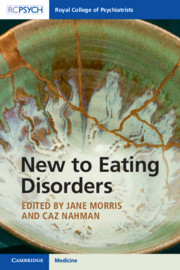Book contents
- New to Eating Disorders
- New to Eating Disorders
- Copyright page
- Contents
- Foreword
- Acknowledgements
- Introduction for Trainees and Students
- Chapter 1 What Are Eating Disorders?
- Chapter 2 Causes and Formulation
- Chapter 3 The Carer’s Perspective
- Chapter 4 Risk Assessment and Management
- Chapter 5 Ethical and Medico-legal Issues
- Chapter 6 Management of Eating Disorders
- Chapter 7 Nutritional Care: Dietetic Interventions Including Behavioural Interventions
- Chapter 8 Exercise and Activity
- Chapter 9 Body Image
- Chapter 10 Severe and Enduring Eating Disorders
- Chapter 11 Children and Adolescents
- Chapter 12 Transitions
- Index
- References
Chapter 12 - Transitions
Published online by Cambridge University Press: 12 June 2020
- New to Eating Disorders
- New to Eating Disorders
- Copyright page
- Contents
- Foreword
- Acknowledgements
- Introduction for Trainees and Students
- Chapter 1 What Are Eating Disorders?
- Chapter 2 Causes and Formulation
- Chapter 3 The Carer’s Perspective
- Chapter 4 Risk Assessment and Management
- Chapter 5 Ethical and Medico-legal Issues
- Chapter 6 Management of Eating Disorders
- Chapter 7 Nutritional Care: Dietetic Interventions Including Behavioural Interventions
- Chapter 8 Exercise and Activity
- Chapter 9 Body Image
- Chapter 10 Severe and Enduring Eating Disorders
- Chapter 11 Children and Adolescents
- Chapter 12 Transitions
- Index
- References
Summary
We can think of transitions as ‘life events’ or ‘life-cycle changes’. In addition, there can be specific challenges for those with eating disorders due to the specific cognitive difficulties they present. These include a lack of flexibility and difficulty in terms of seeing the ‘bigger picture’ when faced with a particular issue. Those patients with anorexia and strongly obsessional disorders can find ‘set shifting’ particularly difficult – that is, when the ‘rules’ change, they struggle to shift to the new rules instead of the old ones. It is hard for them to learn new adaptive skills or mobilise and generalise learned adaptive skills to a new situation. Their capacity to adapt is further impaired by starvation and low weight, which exacerbates rigidity of thinking.
- Type
- Chapter
- Information
- New to Eating Disorders , pp. 84 - 92Publisher: Cambridge University PressPrint publication year: 2020

